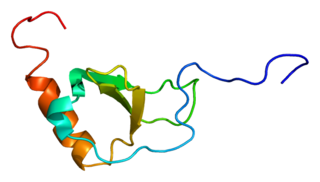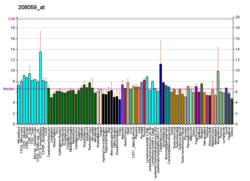A co-receptor is a cell surface receptor that binds a signalling molecule in addition to a primary receptor in order to facilitate ligand recognition and initiate biological processes, such as entry of a pathogen into a host cell.
Chemokine ligands 4 previously known as macrophage inflammatory protein (MIP-1β), is a protein which in humans is encoded by the CCL4 gene. CCL4 belongs to a cluster of genes located on 17q11-q21 of the chromosomal region. Identification and localization of the gene on the chromosome 17 was in 1990 although the discovery of MIP-1 was initiated in 1988 with the purification of a protein doublet corresponding to inflammatory activity from supernatant of endotoxin-stimulated murine macrophages. At that time, it was also named as "macrophage inflammatory protein-1" (MIP-1) due to its inflammatory properties.
Chemokine ligand 1 (CCL1) is also known as small inducible cytokine A1 and I-309 in humans. CCL1 is a small glycoprotein that belongs to the CC chemokine family.

Chemokine ligand 8 (CCL8), also known as monocyte chemoattractant protein 2 (MCP2), is a protein that in humans is encoded by the CCL8 gene.

Chemokine ligand 20 (CCL20) or liver activation regulated chemokine (LARC) or Macrophage Inflammatory Protein-3 (MIP3A) is a small cytokine belonging to the CC chemokine family. It is strongly chemotactic for lymphocytes and weakly attracts neutrophils. CCL20 is implicated in the formation and function of mucosal lymphoid tissues via chemoattraction of lymphocytes and dendritic cells towards the epithelial cells surrounding these tissues. CCL20 elicits its effects on its target cells by binding and activating the chemokine receptor CCR6.

Chemokine ligand 18 (CCL18) is a small cytokine belonging to the CC chemokine family. The functions of CCL18 have been well studied in laboratory settings, however the physiological effects of the molecule in living organisms have been difficult to characterize because there is no similar protein in rodents that can be studied. The receptor for CCL18 has been identified in humans only recently, which will help scientists understand the molecule's role in the body.

C-C motif chemokine 22 is a protein that in humans is encoded by the CCL22 gene.

CCL17 is a powerful chemokine produced in the thymus and by antigen-presenting cells like dendritic cells, macrophages, and monocytes. CCL17 plays a complex role in cancer. It attracts T-regulatory cells allowing for some cancers to evade an immune response. However, in other cancers, such as melanoma, an increase in CCL17 is linked to an improved outcome. CCL17 has also been linked to autoimmune and allergic diseases.

Fractalkine, also known as chemokine ligand 1, is a protein that in humans is encoded by the CX3CL1 gene.

Chemokine ligand 19 (CCL19) is a protein that in humans is encoded by the CCL19 gene.
CC chemokine receptors are integral membrane proteins that specifically bind and respond to cytokines of the CC chemokine family. They represent one subfamily of chemokine receptors, a large family of G protein-linked receptors that are known as seven transmembrane (7-TM) proteins since they span the cell membrane seven times. To date, ten true members of the CC chemokine receptor subfamily have been described. These are named CCR1 to CCR10 according to the IUIS/WHO Subcommittee on Chemokine Nomenclature.
Chemokine ligand 16 (CXCL16) is a small cytokine belonging to the CXC chemokine family. Larger than other chemokines, CXCL16 is composed of a CXC chemokine domain, a mucin-like stalk, a transmembrane domain and a cytoplasmic tail containing a potential tyrosine phosphorylation site that may bind SH2. These are unusual features for a chemokine, and allow CXCL16 to be expressed as a cell surface bound molecule, as well as a soluble chemokine. CXCL16 is produced by dendritic cells found in the T cell zones of lymphoid organs, and by cells found in the red pulp of the spleen. Cells that bind and migrate in response to CXCL16 include several subsets of T cells, and natural killer T (NKT) cells. CXCL16 interacts with the chemokine receptor CXCR6, also known as Bonzo. Expression of CXCL16 is induced by the inflammatory cytokines IFN-gamma and TNF-alpha. The gene for human CXCL16 is located on chromosome 17.

Chemokine receptor 6 also known as CCR6 is a CC chemokine receptor protein which in humans is encoded by the CCR6 gene. CCR6 has also recently been designated CD196. The gene is located on the long arm of Chromosome 6 (6q27) on the Watson (plus) strand. It is 139,737 bases long and encodes a protein of 374 amino acids.

C-C chemokine receptor type 10 is a protein that in humans is encoded by the CCR10 gene.

C-C chemokine receptor type 4 is a protein that in humans is encoded by the CCR4 gene. CCR4 has also recently been designated CD194.

C-C chemokine receptor type 3 is a protein that in humans is encoded by the CCR3 gene.

Chemokine-binding protein 2 is a protein that in humans is encoded by the CCBP2 gene.

C-X-C chemokine receptor type 6 is a protein that in humans is encoded by the CXCR6 gene. CXCR6 has also recently been designated CD186.

C-C motif chemokine 4-like is a protein that in humans is encoded by the CCL4L1 gene.

C-C motif chemokine ligand 27 is a protein that in humans is encoded by the CCL27 gene.














